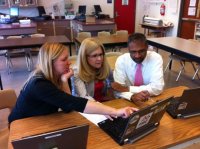PBL Course Development: Collaboration Among Colleagues
At Sammamish High School, we're developing and implementing a comprehensive problem-based learning program for all of our students. Working closely with my peers during this process has become one of the highlights of my career as an educator. These last two years I've been granted (literally and figuratively) the space and time to exchange ideas, learn from others and feel the satisfaction of knowing that I grow as a professional with each exchange. I have two very different teacher collaboration experiences to relate.
Stamina and Momentum
Last year, my first experience with a PBL collaborative group was working with six teachers on an integrated biology/chemistry course. I had come to know and work with each of these teachers to varying degrees in my time at Sammamish High. We met during the final period of the day. The upside was that it allowed me to fully focus on the task at hand and put aside any immediate stress I had over an upcoming class (because, even after 17 years, I always obsess about each little thing that needs to happen before my next group of kids come in). The last period meeting time allowed me the luxury of suspending that worry, and it was wonderful being able to begin each work meeting worry-free.
This came at a price, however. I was very tired and a little worn down by end of day. PBL work has many facets, and creativity and stamina are really important. After teaching my classes, it was difficult to be creative, and on many occasions I had very little stamina left. Because it was easy to lose focus on the task at hand, I really had to be mindful of how I spent the time. It wasn't just me; my partners faced the same issues -- but we never all crashed at the same time. There were always two or three team members who maintained the momentum needed to get through what we needed to do.
Attachment and Agreement
Another interesting thing about last year's collaboration was the fact that the design group had been formed the previous year (2010-11). Again, for me this was both an advantage and a challenge. Because much of the groundwork for the course was in place, we could move at a good pace in creating the nuts and bolts of the major projects/problems. But on some occasions, I felt that questioning an aspect of the work could lead the group in a different direction, unraveling the original work. Because the original work was extensive, changing course after the fact was problematic. Also, not having taught chemistry since 1998 (yikes!!!) and never having taught the biology/chemistry course, I really didn't feel comfortable questioning the vision behind it. It was much more expedient to move forward and work with the existing plan without feeling like I would be setting things back.
But that's the thing about collaboration -- you are never in a place where your ideas are the only ones, so you must be able to contribute without being too attached to the outcome. That was tough to do, and sometimes I felt trapped by the existing work. On those few occasions, however, my consolation was that refining the course would continue during implementation. And it has. We are in discussions around rearranging topics for the first year course that allow more biology content at the start of the year (one of my worries last year). I still worry if we've truly integrated the course or just split up the content into sections . . . but the work continues
Little and Big Pictures
This year I am a part of a new design team for AP biology. We meet just after lunch, can usually suspend the angst of upcoming classes, and most often have all the energy it takes to do the work at hand. The group has only three members (including me), and the work feels completely different this year. One major factor is that I’ve taught AP biology for five years now and have lots of background and experience with the essential learning statements prescribed by the College Board's new curriculum framework. That makes it so much easier to question assumptions as we lay down the bones the new course. I'm not saying it's been easy. There were definitely times when all of us got caught up in the semantics of those essential learnings, trying to decipher every word almost like an obsessive/compulsive exercise. Happily, we arrived at a more productive outlook and are more focused than ever before on creating a truly engaging course.
Collaboration with my peers has certainly pushed my thinking and my attachments to cherished methods. It has stretched me, allowed me to realize what I should hold onto and what I should let go. It's been tough, challenging -- but most of all, extremely satisfying.
Editor's Note: Visit "Case Study: Reinventing a Public High School with Problem-Based Learning" to stay updated on Edutopia's coverage of Sammamish High School.
